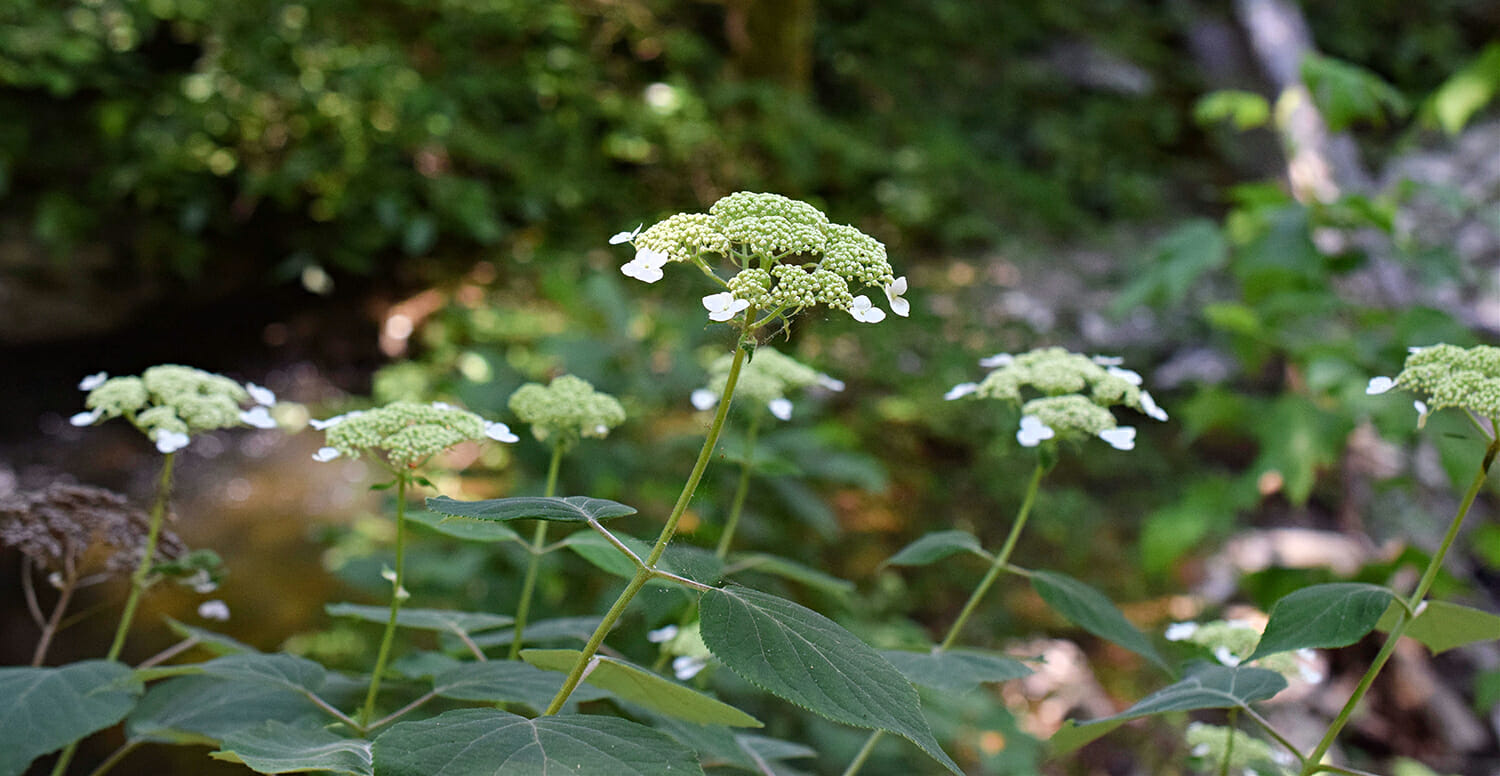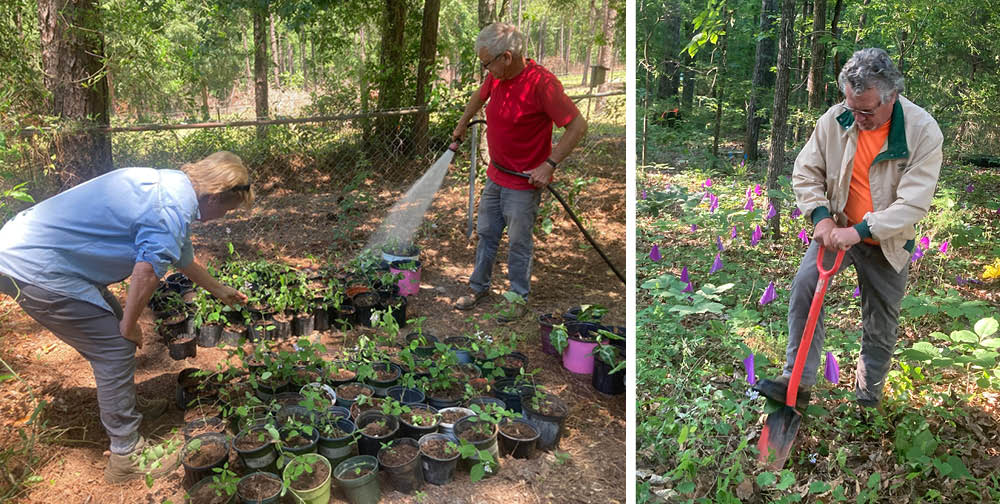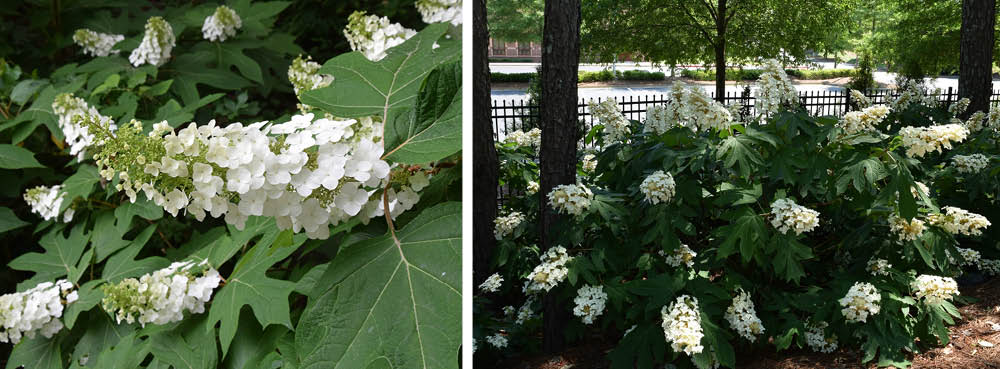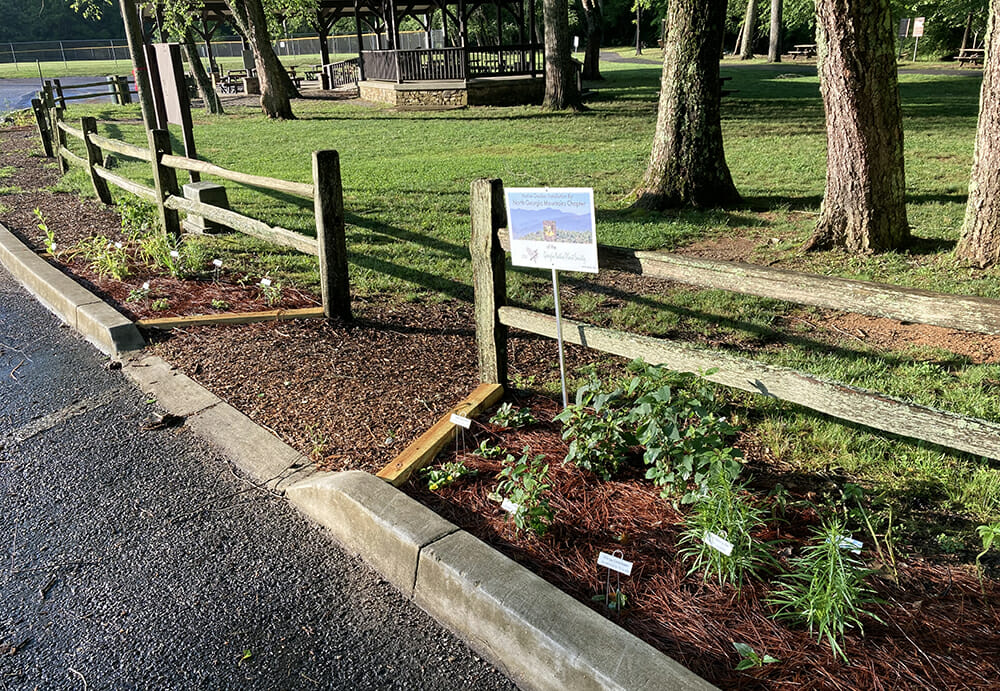
Smooth hydrangea (Hydrangea arborescens) is one of the plants described in Plant Spotlight this month.
In this issue ...
- Two chapters collaborate on plant rescue
- Spotlight on hydrangea
- Chapter News
GNPS Chapters assist GDOT and DNR with plant rescue
Amy Heidt
The Coastal Plain Chapter, with assistance from GDOT Ecologist Brian Davis, Georgia DNR Senior Botanist Lisa Kruse, and Georgia DNR Heritage Botanist Gemma Milly, coordinated a plant rescue for several species of concern that would be impacted by an upcoming road construction project in Twiggs County. Members of the Coastal Plain Chapter (Amy Heidt, Paul Sumner, and Heather Brasell) made a site visit in early May to determine the extent of the area and the number of plants involved. Plants of concern were identified within the delineated DOT boundaries, which were marked to ensure that no incursions were made onto private property.

Left: Amy Heidt and Paul Sumner watering rescued plants at the Coastal Plain Chapter propagation facility. Right: Greg Lewis working at the rescue site in Twiggs County.
Following GDOT and DNR approval of all visits and activities, members of the Coastal Plain and Fringed Campion chapters made visits to the site to flag the plant species of concern.
At follow-up visits to the site, GNPS volunteers dug and potted the plants (on site) to be used for DNR restoration projects. At one of these visits, botanists Steve Bowling and Tom Diggs joined the group and advised on several more species to consider for rescue. With permission from GDOT and DNR, volunteers rescued additional plants to grow for use as local ecotype plants for gathering seeds for propagation.
Several hundred plants were rescued for DNR conservation and are being held at the Coastal Plain propagation facility in Tift County until such time as DNR can have them placed in a proper conservation setting. Plants were potted and watered in the field as dug. Plants have survived the transition to the holding site and are thriving.
The members of the Coastal Plain Chapter who participated in this effort included Amy Heidt, Paul Sumner, Heather Brasell and Marilynne Marshall. Participating members of the Fringed Campion Chapter included Greg Lewis, Whit Kirkland, Ann Amis, Donna English, Donna Bennett, Linda Bratcher, and John Harrison.
Both chapters would like to thank Brian Davis for the invitation to participate, the excellent maps, the personnel coordination with DNR, and the site coordination with DOT. Our thanks extend to Lisa Kruse and Gemma Milly for their guidance and advice during the process as well.
Plant Spotlight: Native Hydrangea
Ellen Honeycutt
 Oakleaf hydrangea (Hydrangea quercifolia).
Oakleaf hydrangea (Hydrangea quercifolia) is probably our best known native hydrangea species, but I’m here to tell you that the others are worth knowing and worth using in our landscapes. With four shrubs and a vine, we have five species of Hydrangea in Georgia.
Oakleaf hydrangea was first documented in Georgia by William Bartram in 1775 in Crawford County. The native range is along the western side of the state (there is much more of it in Alabama). I have seen it in the wild at Cloudland Canyon State Park in Dade County. It is a large shrub, with leaves that resemble those of certain oaks and flowers in a panicle arrangement composed of showy, cream-colored sterile florets and insignificant fertile flowers. The sterile flowers age to pink, giving additional interest to the look of the plant during summer. Fall color can be very nice and exfoliating bark on mature shrubs is said to contribute to four seasons of interest. This shrub is widely cultivated and available at many nurseries. It was our first Plant of the Year when the program started in 2000.
Our second, and most naturally distributed species, is smooth hydrangea (Hydrangea arborescens). A medium-sized shrub, it is rather modest in the wild. Its flat-topped clusters of small fertile flowers only occasionally have sterile florets around the edges. In the wild it is found on shaded streamsides where it helps to hold the bank. It is native to most of the upper half of the state. Nurseries have bred showier forms of this species, creating large balls of sterile florets. The oldest known cultivated one was discovered in the wild near Anna, Illinois in 1910 and later named ‘Annabelle.’ The insects do prefer the wild ones which offer more pollen and nectar.
The next two species are very similar in appearance to the smooth hydrangea. Ashy hydrangea (Hydrangea cinerea) is found in the NW corner of the state, while silverleaf hydrangea (Hydrangea radiata) is in the NE corner. At first glance, one might think both of these are the smooth hydrangea, and they are found in similar areas (shaded slopes, ravines, streamsides). Both were named to reflect the pale coloration on the underside of the leaves which is caused by small hairs. If you’d like to read more about these 3 species and their use in the garden, see this trial garden report of them by Mt. Cuba Center.

Left: Smooth hydrangea (Hydrangea arborescens). Right: Climbing hydrangea (Hydrangea barbara).
The fifth species is a vine that was previously known as Decumaria barbara but which is now considered to be Hydrangea barbara. It was often commonly referred to as climbing hydrangea but also called woodvamp. This species has almost statewide distribution. Its thick, glossy leaves are arranged in opposite pairs as is true for all hydrangea species. It climbs up trees in moist wooded areas with vines covered in hairs, very much resembling a poison ivy vine; however the leaf arrangement on poison ivy is alternate (impress your friends by pointing out the difference!). The blooms are clusters of small creamy flowers that dry to a cluster of capsules that may still be present in winter as well as a few fading pale yellow leaves. While you might find it scrambling on the ground, it does need to climb in order to bloom.
Look for all of our species of Hydrangea to be blooming now. They are reliable late May to June bloomers. They are all susceptible to deer browsing but with careful siting can be a welcome addition to the native garden.
Chapter News
Fringed Campion Chapter
The Fringed Campion Chapter has the following activities planned in June:
- June 5th — General Chapter Meeting, 6 p.m. at Godsey Science Center, Room 203, Mercer University, 1501 Mercer University Drive, Macon. There will be a business meeting, a presentation by Dr Ferrari, Reflections from a Bird Bath: What Game Cameras Can Teach Us About Birds, and a seed/plant swap.
- June 25th — Native Plant Day with Master Gardeners at Macon Museum of Art and Science. There will be native plants for sale and a presentation on native plants by a chapter board member at 11 a.m.
North Georgia Mountains Chapter

Meek's Park in Blairsville.
The June 11th meeting of the North Georgia Mountains chapter will include a presentation by Mark Warren, author and head of the Medicine Bow wilderness school, on the applications of native plants by the indigenous people. He has spoken to some other gatherings of the Georgia Native Plant Society in the past, and if any of you missed those, or want to see him again, you are free to join us. The details about the meeting are on the GNPS website.
We have installed native plant beds at Meek’s Park in Blairsville, at the two entrances through the fence separating the end parking lot from the gazebo. This is a place with much activity which should help meet the goal of introducing people to native plants.
Intown Atlanta Chapter
Please join the Intown Atlanta Chapter for a panel discussion on Adding Native Plants to Your Intown Landscape in partnership with Trees Atlanta on Sunday, June 26, from 3 p.m. to 5 p.m. Attendees will learn practical and usable advice on how to add native plants to their yards, and help contribute to the health of Atlanta's urban forest. The event will be held at Trees Atlanta's Kendeda Center located at 225 Chester Ave SE. Come prepared with questions and to meet fellow native plant enthusiasts! Advance registration for this event is required. Check the chapter's social media and web page for a registration link. |